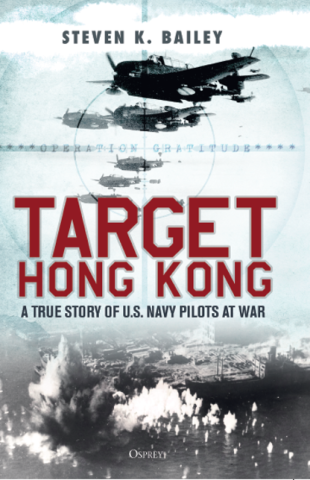Book excerpt from Target Hong Kong: A True Story of U.S. Navy Pilots at War by Steven K. Bailey
Published in February 2024 by Osprey/Bloomsbury in the UK.
Target Hong Kong describes the U.S. Navy’s ambitious but flawed attempt to bomb Hong Kong during Operation Gratitude, which involved nearly 100 warships and close to a thousand carrier-based warplanes. The airstrikes of January 15-16, 1945, destroyed a Japanese tanker convoy anchored at Hong Kong but cost nineteen American aircraft, inflicted collateral damage on the nearby and neutral Portuguese colony of Macau, and killed fourteen Allied prisoners in a tragic accidental bombing of the Stanley internment camp. Target Hong Kong brings this massive military operation down to a human scale by recounting the navy air raids through the experiences of seven men whose lives intersected at Hong Kong in January 1945, including six naval aviators and Stanley internee Ray Jones, who is well known to Gwulo afficionados. In the excerpt below, two of the central characters have taken off from the aircraft carrier USS Yorktown and flown to Hong Kong for a dive-bombing mission over Victoria Harbor:
The Yorktown lost the third plane, an SB2C-4 with the number 104 painted on its fuselage and twenty-four-year-old Lt. (j.g.) John H. Lavender in the cockpit. In the rear-facing backseat, twenty-one-year-old Jean F. Balch, ARM3c, had his canopy open and his twin .30-caliber machine guns ready to fire. Eleven other Helldivers from VB-3 bucked in the turbulent air around them, each laden with a bombload of 1,250 pounds. As the shoreline of Kowloon slid past far below and the ship-spangled harbor came into view, Lavender tipped number 104 into a dive from 13,000 feet. Balch plummeted towards the harbor on his back, his guns pointing nearly straight up, as Lavender kept his Mark 8 bombsight aligned on one of the Japanese tankers. He released their payload at the bottom of the dive, a maneuver so aerodynamically violent that the pullout could buckle wing panels, and then they flew into a blizzard of flak. With a flash, the bomb bay caught fire. Milliseconds later the engine quit, oil trailed out from the cowling in a long black ribbon, and the roar of the R-2600 gave way to a terrifying silence and the whistle of the slipstream. Lavender failed to respond over the intercom and Balch assumed he had been killed or incapacitated. When Balch glanced at his altimeter, it read 600 feet, and he had been told to assume that if it read 600, he was actually at 350 feet.
Acting on instinct and adrenaline, Balch pushed himself up and out of the open back cockpit. Moments later number 104 slammed into a mountainside on Hong Kong Island with Lavender still strapped in the cockpit. Whipped about by the snap of the opening chute, Balch saw buildings whirling below him and caught kaleidoscopic views of the harbor sparking with pyrotechnic violence. Rifle bullets started tearing through his parachute canopy as he drifted towards the shoreline of Kennedy Town. He hit the side of a bombed-out building, the air puffed out of his deflating parachute, and he dropped into a pile of coiled-up chicken wire for a relatively soft landing.
Interested in reading more? Target Hong Kong is available from Osprey UK and Amazon worldwide.

Comments
Congrats
Congrats on the new book, Steven, looking forward to grabbing a copy.
UXBs
Not to mention the UXBs which have been discovered and defused along the North Wanchai waterfront, Kai Tak and Happy Valley over the last few years!!…….or does it. Guess I need to get a copy to find out! Thanks